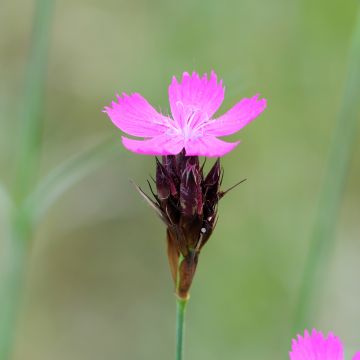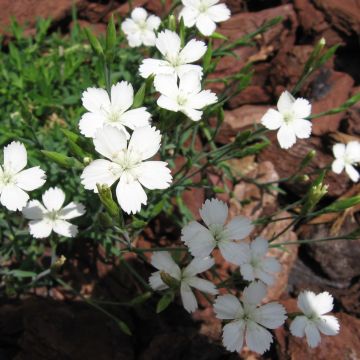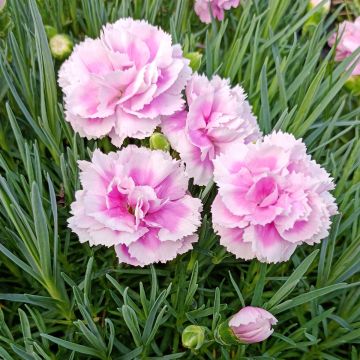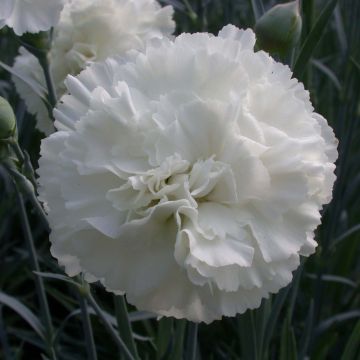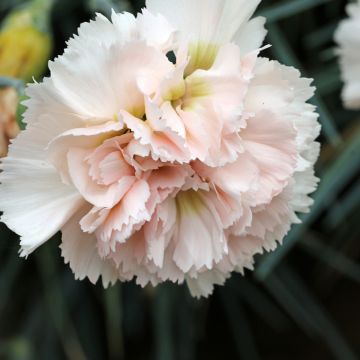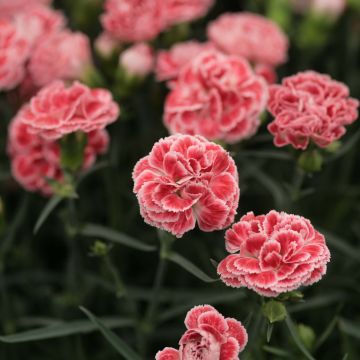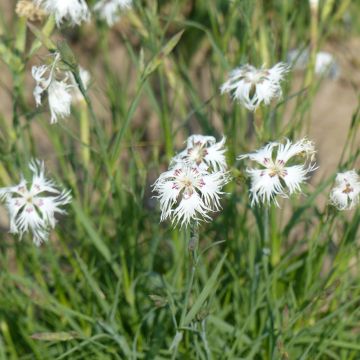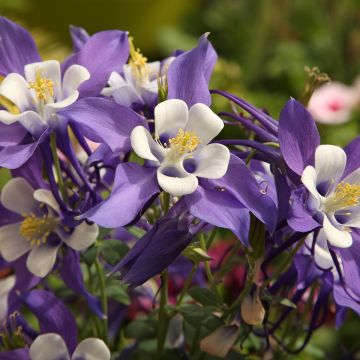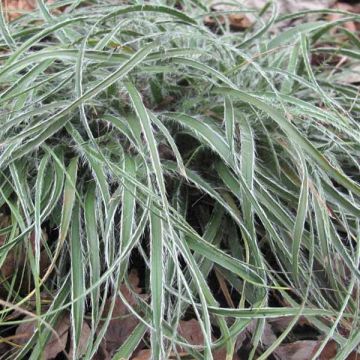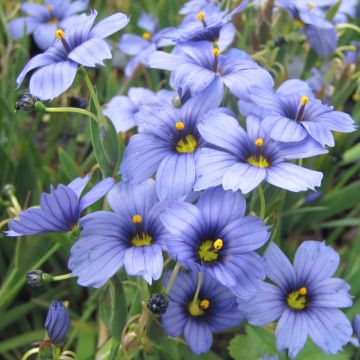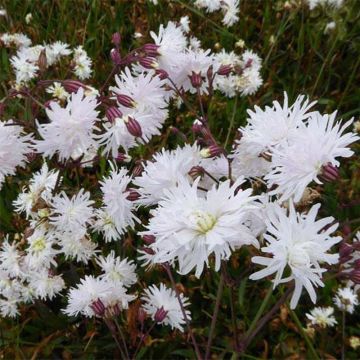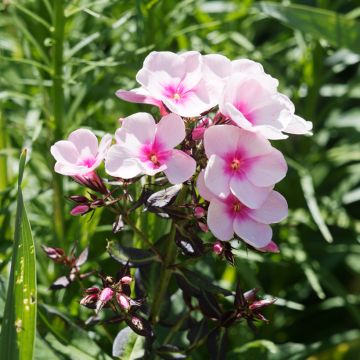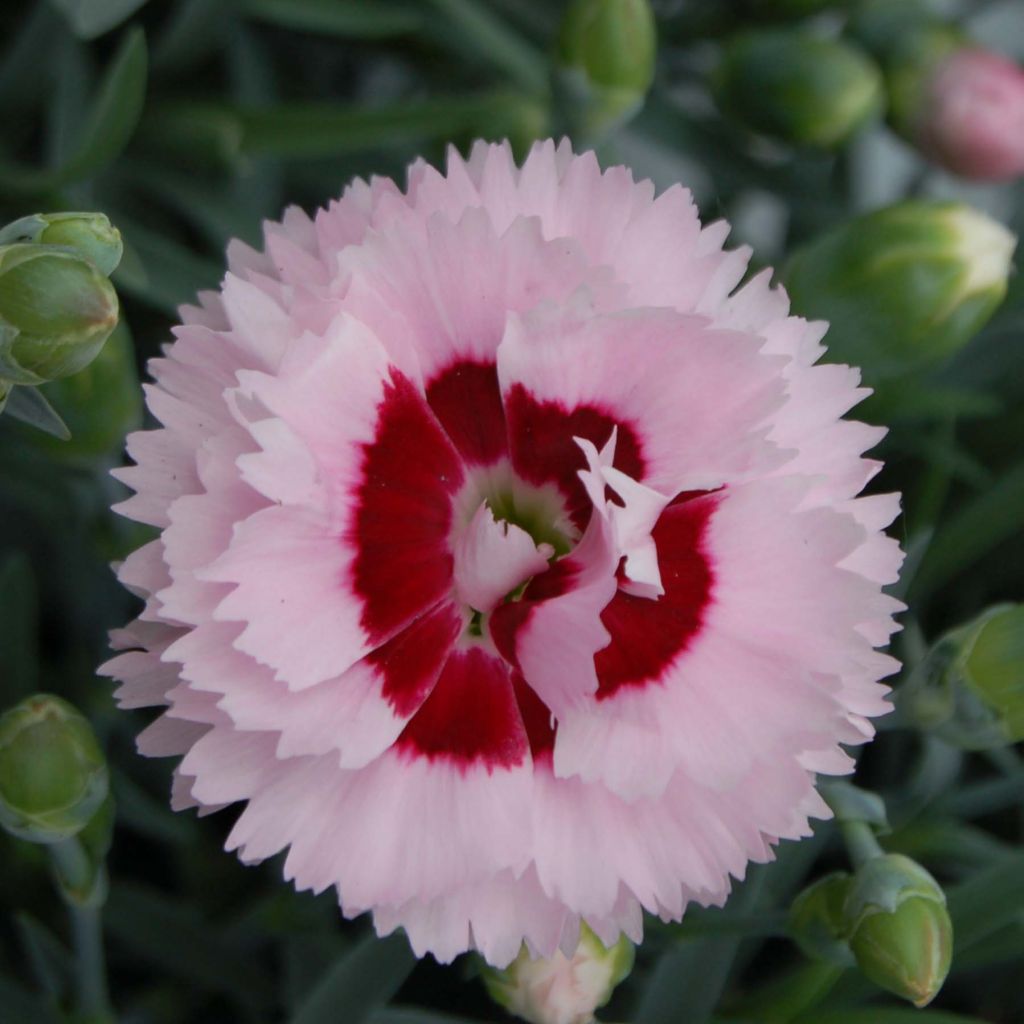

Dianthus plumarius Scent First Raspberry Sundae


Dianthus plumarius Scent First Raspberry Sundae
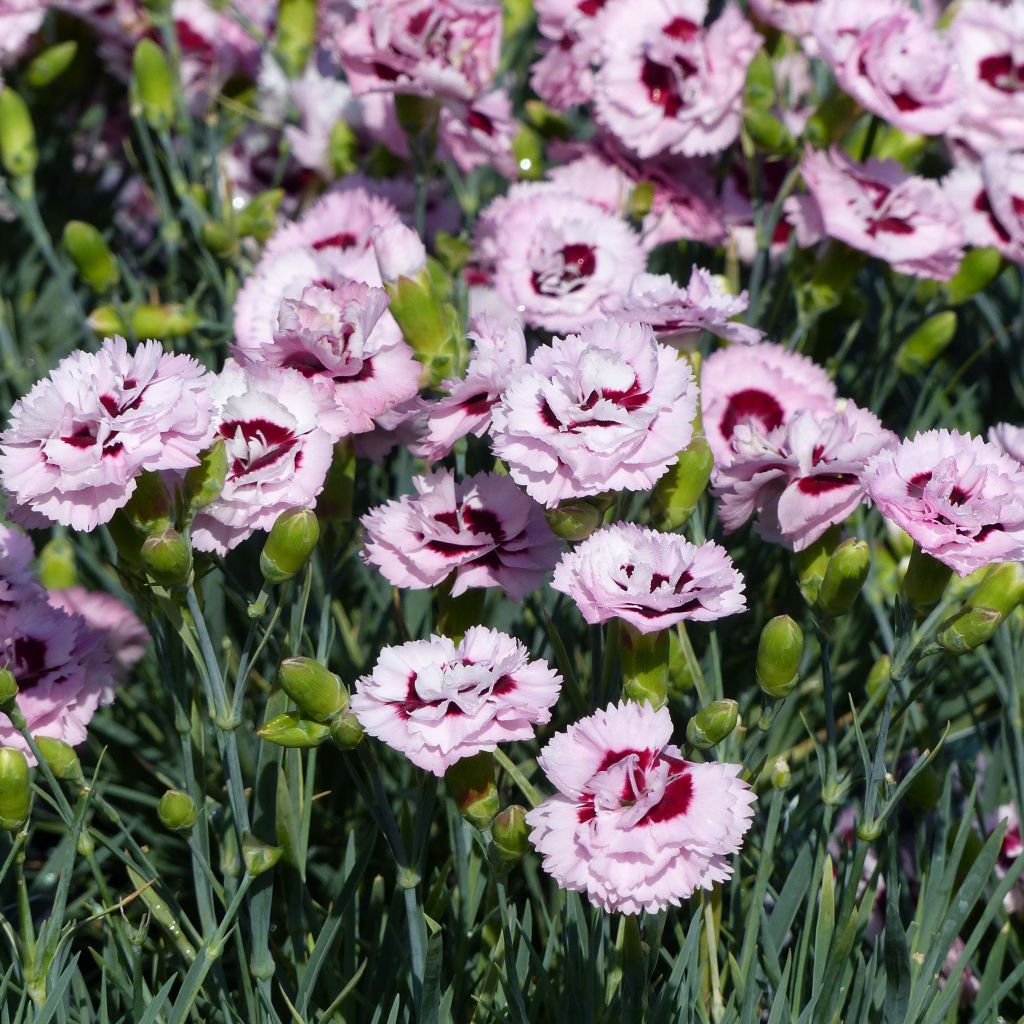

Dianthus plumarius Scent First Raspberry Sundae


Dianthus plumarius Scent First Raspberry Sundae
Dianthus plumarius Scent First Raspberry Sundae
Dianthus x plumarius Scent First® Raspberry Sundae (Devon yolande)
Garden Pink, Cottage Pink, Grass Pink, Carnation
Young plant delivered well protected in the packaging, little risk of damage during transport... now we just have to wait for its flowering, but overall satisfied.
Aurelie D., 13/10/2018
Special offer!
Receive a €20 voucher for any order over €90 (excluding delivery costs, credit notes, and plastic-free options)!
1- Add your favorite plants to your cart.
2- Once you have reached €90, confirm your order (you can even choose the delivery date!).
3- As soon as your order is shipped, you will receive an email containing your voucher code, valid for 3 months (90 days).
Your voucher is unique and can only be used once, for any order with a minimum value of €20, excluding delivery costs.
Can be combined with other current offers, non-divisible and non-refundable.
Home or relay delivery (depending on size and destination)
Schedule delivery date,
and select date in basket
This plant carries a 12 months recovery warranty
More information
We guarantee the quality of our plants for a full growing cycle, and will replace at our expense any plant that fails to recover under normal climatic and planting conditions.
Would this plant suit my garden?
Set up your Plantfit profile →
Description
The Dianthus Raspberry Sundae is a modern Carnation variety belonging to the Scent First series, made up of plants with a compact habit and vibrant, fragrant flowering, particularly suited for pot cultivation. This 'Raspberry Sundae' variety, with its contrasting colours, offers semi-double flowers, pale pink with a raspberry centre. Its flowering starts in June, and is abundant and prolonged. It is also an excellent perennial for sunny borders, where it forms persistent cushions of beautiful grey-blue even in winter.
The Carnation or Dianthus 'Scent First Raspberry Sundae' belongs to the caryophyllaceae family. It is a cultivar selected in England, resulting from cross-breeding between D. plumarius and D. gratianopolitanus, among others. Dianthus plumarius is a European perennial that is the main ancestor of different Carnation groups, both old-fashioned and modern. Dianthus gratianopolitanus is native to Europe and Asia, and has passed on to its descendants, among other things, its compact habit and wonderful clove fragrance. The growth of this Carnation is quite fast. Its mature size will not exceed 25cm (10in) in height with a spread of 25cm (10in) or more. This Carnation forms a dense clump, from which emerge, from June to August, wide 4-5cm (2in) semi-double flowers with fringed petals, borne at the end of short, often branched stems. Its linear, glabrous, pointed, evergreen and leathery leaves are a superb grey-blue.
The Dianthus 'Raspberry Sundae' is a very pretty plant for terraces or balconies, hardy to at least -15°C, not demanding in terms of water, but craving sun. It will also thrive in well-drained borders, slopes, and rockeries. Its beautiful scented flowers bring undeniable charm to even the simplest decor. For example, it can be placed in front of other carnations, white, red or pink ('Devon Dove', 'Devon Magic', 'Devon Cream', 'Letitia Wyatt'), or to accompany the blue bells of campanulas, the lavender mounds of catmints, or flowering cushions such as rock roses, campions, wall bellflowers, Caucasus wallflowers, creeping phlox, Erigeron karvinskianus, and bloody cranesbill (Geranium sanguineum). To evoke gardens of the past, a small border of these delightful carnations can be planted at the foot of peony clumps and old-fashioned roses. This plant forms a lovely garnish between the stones of a wall or paving, in a trough or in a container.
Report an error about the product description
Dianthus plumarius Scent First Raspberry Sundae in pictures
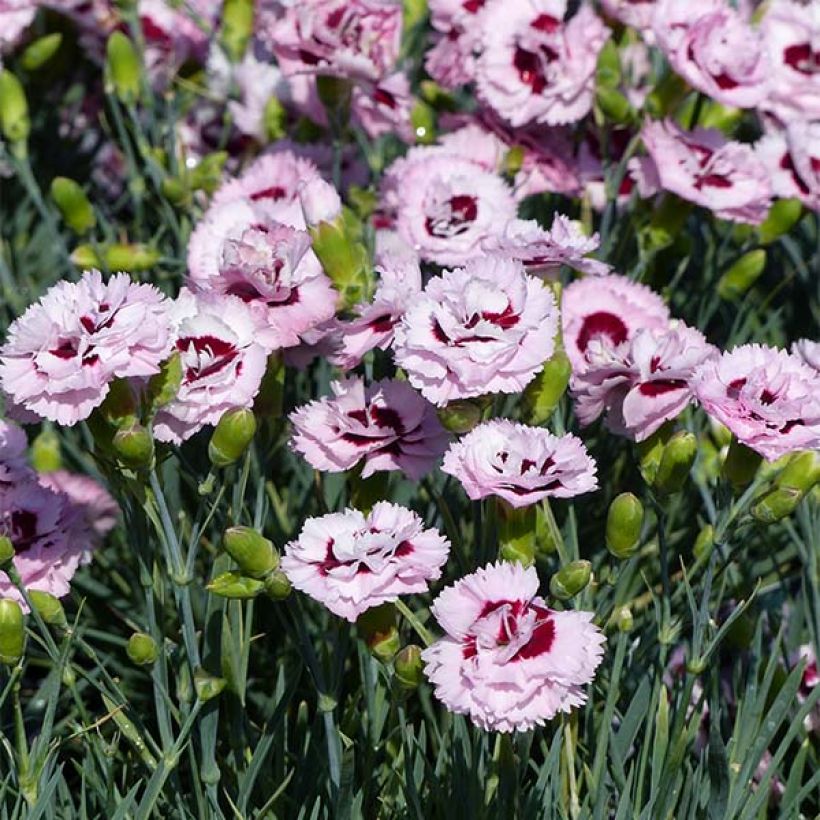



Flowering
Foliage
Plant habit
Botanical data
Dianthus
x plumarius
Scent First® Raspberry Sundae (Devon yolande)
Caryophyllaceae
Garden Pink, Cottage Pink, Grass Pink, Carnation
Cultivar or hybrid
Other Dianthus - Pinks
View all →Planting and care
Plant Dianthus 'Raspberry Sundae' in ordinary soil, but light and permeable, humus-bearing or gravelly, preferably limestone, dry to moist and above all well-drained. A gravel-rich soil produces good results. In open ground, this plant is quite hardy, resistant to temperatures down to -15°C (5°F). It prefers a very sunny exposure. Lightly prune the clump after summer flowering to promote regrowth in September. In a rich soil, trim some of the foliage with shears after flowering to maintain a dense habit. In poor soil, it will be useful to apply a balanced fertilizer in March. It is useful to divide the clumps every 3 years to rejuvenate those whose base is thinning out or by easily creating cuttings or propagating by layering.
Planting period
Intended location
Care
-
, onOrder confirmed
Reply from on Promesse de fleurs
Similar products
Haven't found what you were looking for?
Hardiness is the lowest winter temperature a plant can endure without suffering serious damage or even dying. However, hardiness is affected by location (a sheltered area, such as a patio), protection (winter cover) and soil type (hardiness is improved by well-drained soil).

Photo Sharing Terms & Conditions
In order to encourage gardeners to interact and share their experiences, Promesse de fleurs offers various media enabling content to be uploaded onto its Site - in particular via the ‘Photo sharing’ module.
The User agrees to refrain from:
- Posting any content that is illegal, prejudicial, insulting, racist, inciteful to hatred, revisionist, contrary to public decency, that infringes on privacy or on the privacy rights of third parties, in particular the publicity rights of persons and goods, intellectual property rights, or the right to privacy.
- Submitting content on behalf of a third party;
- Impersonate the identity of a third party and/or publish any personal information about a third party;
In general, the User undertakes to refrain from any unethical behaviour.
All Content (in particular text, comments, files, images, photos, videos, creative works, etc.), which may be subject to property or intellectual property rights, image or other private rights, shall remain the property of the User, subject to the limited rights granted by the terms of the licence granted by Promesse de fleurs as stated below. Users are at liberty to publish or not to publish such Content on the Site, notably via the ‘Photo Sharing’ facility, and accept that this Content shall be made public and freely accessible, notably on the Internet.
Users further acknowledge, undertake to have ,and guarantee that they hold all necessary rights and permissions to publish such material on the Site, in particular with regard to the legislation in force pertaining to any privacy, property, intellectual property, image, or contractual rights, or rights of any other nature. By publishing such Content on the Site, Users acknowledge accepting full liability as publishers of the Content within the meaning of the law, and grant Promesse de fleurs, free of charge, an inclusive, worldwide licence for the said Content for the entire duration of its publication, including all reproduction, representation, up/downloading, displaying, performing, transmission, and storage rights.
Users also grant permission for their name to be linked to the Content and accept that this link may not always be made available.
By engaging in posting material, Users consent to their Content becoming automatically accessible on the Internet, in particular on other sites and/or blogs and/or web pages of the Promesse de fleurs site, including in particular social pages and the Promesse de fleurs catalogue.
Users may secure the removal of entrusted content free of charge by issuing a simple request via our contact form.
The flowering period indicated on our website applies to countries and regions located in USDA zone 8 (France, the United Kingdom, Ireland, the Netherlands, etc.)
It will vary according to where you live:
- In zones 9 to 10 (Italy, Spain, Greece, etc.), flowering will occur about 2 to 4 weeks earlier.
- In zones 6 to 7 (Germany, Poland, Slovenia, and lower mountainous regions), flowering will be delayed by 2 to 3 weeks.
- In zone 5 (Central Europe, Scandinavia), blooming will be delayed by 3 to 5 weeks.
In temperate climates, pruning of spring-flowering shrubs (forsythia, spireas, etc.) should be done just after flowering.
Pruning of summer-flowering shrubs (Indian Lilac, Perovskia, etc.) can be done in winter or spring.
In cold regions as well as with frost-sensitive plants, avoid pruning too early when severe frosts may still occur.
The planting period indicated on our website applies to countries and regions located in USDA zone 8 (France, United Kingdom, Ireland, Netherlands).
It will vary according to where you live:
- In Mediterranean zones (Marseille, Madrid, Milan, etc.), autumn and winter are the best planting periods.
- In continental zones (Strasbourg, Munich, Vienna, etc.), delay planting by 2 to 3 weeks in spring and bring it forward by 2 to 4 weeks in autumn.
- In mountainous regions (the Alps, Pyrenees, Carpathians, etc.), it is best to plant in late spring (May-June) or late summer (August-September).
The harvesting period indicated on our website applies to countries and regions in USDA zone 8 (France, England, Ireland, the Netherlands).
In colder areas (Scandinavia, Poland, Austria...) fruit and vegetable harvests are likely to be delayed by 3-4 weeks.
In warmer areas (Italy, Spain, Greece, etc.), harvesting will probably take place earlier, depending on weather conditions.
The sowing periods indicated on our website apply to countries and regions within USDA Zone 8 (France, UK, Ireland, Netherlands).
In colder areas (Scandinavia, Poland, Austria...), delay any outdoor sowing by 3-4 weeks, or sow under glass.
In warmer climes (Italy, Spain, Greece, etc.), bring outdoor sowing forward by a few weeks.






























